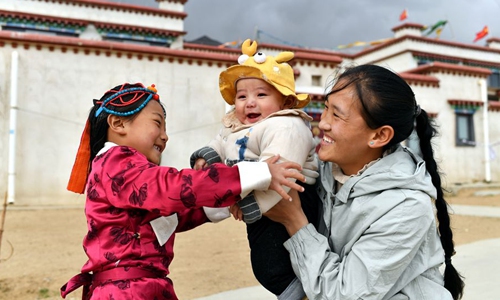
Residents at the Rongma relocation settlement in Gurum Township of Lhasa, capital of southwest China's Tibet Autonomous Region. Photo: Xinhua
As confirmed cases of the COVID-19 is reaching almost 28,000 in India, the condition of overseas Tibetans is concerned, especially those in Dharamsala, which lacks proper medical facilities.
Some overseas Tibetans recognized the measures taken in the past months in Southwest China's Tibet Autonomous Region and even expressed the wish to return to China.
The virus has reportedly infected 27,892 people in India by Monday, killing more than 800. Indian Prime Minister Narendra Modi held a conference on Monday to discuss the extension of the national lockdown on Monday.
A total of 41 confirmed coronavirus cases in Himachal Pradesh, where Dharamsala locates, have been reported, among whom 13 are under treatment, the PTI reported Sun-day.
Dharamsala, where thousands of Tibetan exiles settle, has been under lockdown since late March, after a 69-year old Tibetan man named Tenzin Choephel died from the virus in the region on March 23, media reported. The man arrived in New Delhi from the US on March 15.
On March 31, more than 40 foreign tourists stuck in the lockdown in Dharamsala were sent to New Delhi, India's Economic Times reported.
Dharamsala's healthcare capability is in doubt. Its main medical institute is the Tibetan Medical and Astro-science Institute, which is related to Dalai Lama and aims to promote Tibetan medicine.
"There are some small clinics in Dharamsala with limited medical facilities," Liu Yinghua, an associate research fellow at the Beijing Tibetan Hospital of China Tibetology Research Center, told the Global Times. Liu studied Tibetan medicines in India and is familiar with the healthcare conditions of Tibetans there.
Dharamsala also has a Western hospital with about 20 to 30 beds and can hardly handle urgent or severe patients, he said.
"We saw two small clinics in Dharamsala, both quite shabby," a tourist who visited Dharamsala last year, who asked for anonymity, told the Global Times. "People there do not have a habit of hygiene yet."
Liu said Tibetan communities were spread at several locations in northern and southern India under India's arrangement. But the regions Tibetans gather are usually unstable and the local government often neglects the exiles.
Some Tibetan communities may have a clinic with a doctor dispatched from Dharamsala, Liu said, noting the medical capability is very low.
In 1959, the Dalai Lama fled China in the wake of a failed coup to resist the slave abolition reform along with about 13,000 Tibetans and went into exile in Dharamsala, India, where he set up a state apparatus called the "Tibetan government-in-exile." More Tibetans crossed the board in the following years to enter India, Nepal and Bhutan, becoming "Tibetans in exile."
Overseas Tibetans living in Nepal, India's neighbor, expressed similar concerns over the COVID-19 out-break which they fear may eventually spiral out of control, given the limited medical supply re-sources and prevention capacities in both countries.
Yangzm, who smuggled herself to Nepal via the Himalayas mountains a decade ago, now struggles in locally enforced quarantine at home with daily worries of how long she can survive from a grim life with no income in the city lockdown.
"New coronavirus cases continue to break out in cities along the border with India, posing a risk to Nepal's fragile health system. Tibetans here, like the locals, still lack confidence in the government's ability to prevent and detect disease. But now we have no better way than to lock down the city," Yangzm told the Global Times.
Nepal shares a 1,800-kilometer open border with India, connected with 37 accessible land entry points with India, while with China, it has four such entry points, which have all sealed by the Nepali government over the fears of cross-border movement.
"Every time I called my parents in the Tibet Autonomous Region to alert them about the coronavirus, they said I should be the one to worry about the virus as the outbreak in their region has been well-controlled and they enjoy many conveniences and high-tech services during their quarantine as they can order commodities online or ask the community volunteers to help out with procurement, unlike people living here who can only flock to the streets for buying necessities for limited period of time," said Yangzm.
"It is the time I most desire to go back to Tibet and also the moment I feel most helpless as an expatriate in another country, especially facing a threat to my life or health," she told the Global Times.
Tibet Autonomous Region has been conducting powerful virus-prevention measures in the past months. For instance, all arrivals are demanded to be quarantined for 14 days. Materials are translated into the Tibetan language to promote knowledge and policies about the epidemic.
The region only reported one case of the coronavirus, a tourist from Wuhan, Central China's Hubei Province. He discharged from the hospital in Lhasa on February 12.
There is no layered epidemic prevention web from community level to national departments in Nepal, leaving many breaking the rules to stroll on the streets, she said, adding that the loopholes in local prevention bring her much concern.
Most Tibetans have been hit hard by the disrupted tourism and souvenir sales that they depend on for their livelihoods. There are no local economic support measures, unlike in China, leaving some Tibetans, particularly monks, with no relief but to pray for the abating of the epidemic.
Yangzm said she likes to close her eyes and picture herself going back to her hometown in China and sitting around the bonfire with her family without concerns over the risk of the infection and her economically collapsed venture.


